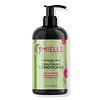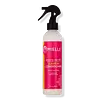What's inside
What's inside
 Key Ingredients
Key Ingredients

No key ingredients
 Benefits
Benefits

 Concerns
Concerns

 Ingredients Side-by-side
Ingredients Side-by-side

Water
Skin ConditioningCetearyl Alcohol
EmollientPolyquaternium-7
Caprylic/Capric Triglyceride
MaskingBehentrimonium Chloride
PreservativeC12-15 Alkyl Benzoate
AntimicrobialParfum
MaskingPersea Gratissima Oil
Skin ConditioningPPG-3 Myristyl Ether
EmollientBiotin
AntiseborrhoeicButyrospermum Parkii Butter
Skin ConditioningCocos Nucifera Oil
MaskingRosmarinus Officinalis Leaf Oil
MaskingMentha Piperita Oil
MaskingOlea Europaea Fruit Oil
MaskingPanthenol
Skin ConditioningBehentrimonium Methosulfate
Diheptyl Succinate
EmollientCapryloyl Glycerin/Sebacic Acid Copolymer
Skin ConditioningCetyl Alcohol
EmollientWater, Cetearyl Alcohol, Polyquaternium-7, Caprylic/Capric Triglyceride, Behentrimonium Chloride, C12-15 Alkyl Benzoate, Parfum, Persea Gratissima Oil, PPG-3 Myristyl Ether, Biotin, Butyrospermum Parkii Butter, Cocos Nucifera Oil, Rosmarinus Officinalis Leaf Oil, Mentha Piperita Oil, Olea Europaea Fruit Oil, Panthenol, Behentrimonium Methosulfate, Diheptyl Succinate, Capryloyl Glycerin/Sebacic Acid Copolymer, Cetyl Alcohol
Water
Skin ConditioningCamellia Sinensis Extract
AntioxidantCocos Nucifera Oil
MaskingCetyl Alcohol
EmollientCetearyl Alcohol
EmollientStearalkonium Chloride
PreservativeSimmondsia Chinensis Seed Oil
EmollientOlea Europaea Fruit Oil
MaskingGlycerin
HumectantDelta-Decalactone
MaskingArgania Spinosa Kernel Oil
EmollientMentha Piperita Leaf Extract
Skin ConditioningYucca Schidigera Root Extract
Skin ConditioningEquisetum Arvense Leaf Extract
AstringentUrtica Dioica Leaf Extract
Skin ConditioningMelissa Officinalis Leaf Extract
Skin ConditioningHydrolyzed Silk
HumectantPotassium Sorbate
PreservativeDiethyl Phthalate
MaskingCitrus Grandis Seed Extract
AstringentCyamopsis Tetragonoloba Gum
Emulsion StabilisingCitric Acid
BufferingWater, Camellia Sinensis Extract, Cocos Nucifera Oil, Cetyl Alcohol, Cetearyl Alcohol, Stearalkonium Chloride, Simmondsia Chinensis Seed Oil, Olea Europaea Fruit Oil, Glycerin, Delta-Decalactone, Argania Spinosa Kernel Oil, Mentha Piperita Leaf Extract, Yucca Schidigera Root Extract, Equisetum Arvense Leaf Extract, Urtica Dioica Leaf Extract, Melissa Officinalis Leaf Extract, Hydrolyzed Silk, Potassium Sorbate, Diethyl Phthalate, Citrus Grandis Seed Extract, Cyamopsis Tetragonoloba Gum, Citric Acid
Ingredients Explained
These ingredients are found in both products.
Ingredients higher up in an ingredient list are typically present in a larger amount.
Cetearyl alcohol is a mixture of two fatty alcohols: cetyl alcohol and stearyl alcohol. It is mainly used as an emulsifier. Emulsifiers help prevent the separation of oils and products. Due to its composition, it can also be used to thicken a product or help create foam.
Cetearyl alcohol is an emollient. Emollients help soothe and hydrate the skin by trapping moisture.
Studies show Cetearyl alcohol is non-toxic and non-irritating. The FDA allows products labeled "alcohol-free" to have fatty alcohols.
This ingredient is usually derived from plant oils such as palm, vegetable, or coconut oils. There is debate on whether this ingredient will cause acne.
Due to the fatty acid base, this ingredient may not be Malassezia folliculitis safe.
Learn more about Cetearyl AlcoholCetyl Alcohol is a fatty alcohol. Fatty Alcohols are most often used as an emollient or to thicken a product.
Its main roles are:
Though it has "alcohol" in the name, it is not related to denatured alcohol or ethyl alcohol.
The FDA allows products labeled "alcohol-free" to have fatty alcohols.
Learn more about Cetyl AlcoholCocos Nucifera Oil is obtained from the kernels of the coconut fruit. In other words, this is coconut oil.
Coconut Oil is rich in fatty acids with lauric acid making up the majority of these. It also contains linoleic acid. Due to this high fatty acid content, coconut oil helps trap moisture and soften skin.
Despite being antibacterial, coconut oil may not be great for acne-prone skin. It is comedogenic and may clog pores. This ingredient may not be safe for malassezia or fungal acne.
Note: Coconut Oil should not replace your sunscreen for UV protection. Studies show it only blocks about 20% of UV.
This oil is non-volatile and has a light scent.
The term 'fragrance' is not regulated in many countries. In many cases, it is up to the brand to define this term. For instance, many brands choose to label themselves as "fragrance-free" because they are not using synthetic fragrances. However, their products may still contain ingredients such as essential oils that are considered a fragrance.
Learn more about Cocos Nucifera OilOlea Europaea Fruit Oil is the fixed oil obtained from the ripe fruit of the Olive. In other words - olive oil.
The primary contents of olive oil are glycerides of the fatty acids linoleic, oleic and palmitic.
Olive oil also contains antioxidants such as Vitamin E. Antioxidants may help reduce signs of aging by fighting unstable free-radical molecules. It also contains Vitamins A (retinol), D, and K.
The squalene in olive oil makes it a great emollient. Emollients help soothe and soften your skin by trapping moisture in. This makes olive oil a great skin moisturizer.
Studies show olive oil to have antibacterial and antifungal properties in low concentrations. Another study found olive oil irritated sensitive oily skin. We always recommend speaking with a professional about using this ingredient in your routine.
Due to the fatty acid content, this ingredient may not be fungal-acne safe.
Learn more about Olea Europaea Fruit OilWater. It's the most common cosmetic ingredient of all. You'll usually see it at the top of ingredient lists, meaning that it makes up the largest part of the product.
So why is it so popular? Water most often acts as a solvent - this means that it helps dissolve other ingredients into the formulation.
You'll also recognize water as that liquid we all need to stay alive. If you see this, drink a glass of water. Stay hydrated!
Learn more about Water